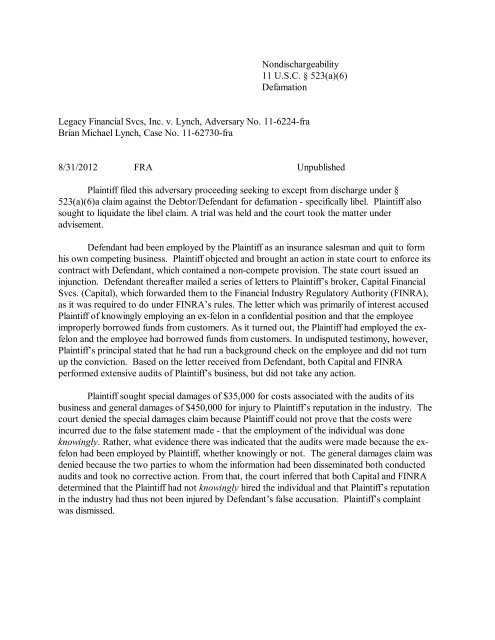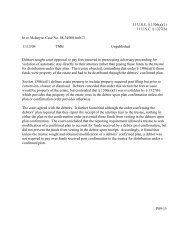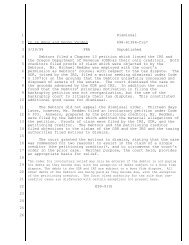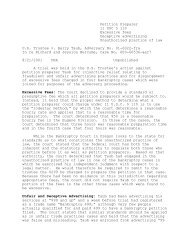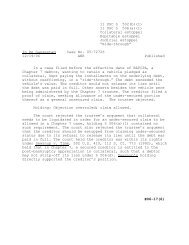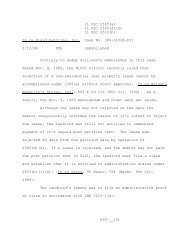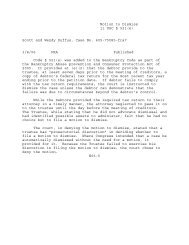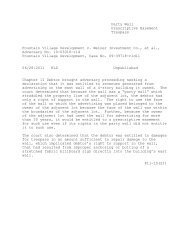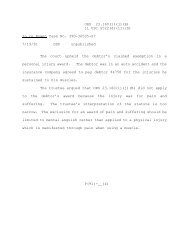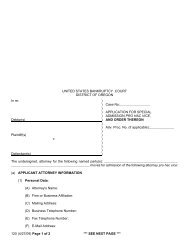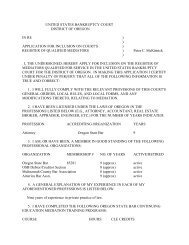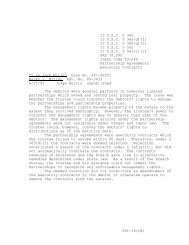in re legacy financial services, inc. vs brian ... - District of Oregon
in re legacy financial services, inc. vs brian ... - District of Oregon
in re legacy financial services, inc. vs brian ... - District of Oregon
You also want an ePaper? Increase the reach of your titles
YUMPU automatically turns print PDFs into web optimized ePapers that Google loves.
Nondischargeability11 U.S.C. § 523(a)(6)DefamationLegacy F<strong>in</strong>ancial Svcs, Inc. v. Lynch, Adversary No. 11-6224-fraBrian Michael Lynch, Case No. 11-62730-fra8/31/2012 FRA UnpublishedPla<strong>in</strong>tiff filed this adversary proceed<strong>in</strong>g seek<strong>in</strong>g to except from discharge under §523(a)(6)a claim aga<strong>in</strong>st the Debtor/Defendant for defamation - specifically libel. Pla<strong>in</strong>tiff alsosought to liquidate the libel claim. A trial was held and the court took the matter underadvisement.Defendant had been employed by the Pla<strong>in</strong>tiff as an <strong>in</strong>surance salesman and quit to formhis own compet<strong>in</strong>g bus<strong>in</strong>ess. Pla<strong>in</strong>tiff objected and brought an action <strong>in</strong> state court to enforce itscontract with Defendant, which conta<strong>in</strong>ed a non-compete provision. The state court issued an<strong>in</strong>junction. Defendant the<strong>re</strong>after mailed a series <strong>of</strong> letters to Pla<strong>in</strong>tiff’s broker, Capital F<strong>in</strong>ancialSvcs. (Capital), which forwarded them to the F<strong>in</strong>ancial Industry Regulatory Authority (FINRA),as it was <strong>re</strong>qui<strong>re</strong>d to do under FINRA’s rules. The letter which was primarily <strong>of</strong> <strong>in</strong>te<strong>re</strong>st accusedPla<strong>in</strong>tiff <strong>of</strong> know<strong>in</strong>gly employ<strong>in</strong>g an ex-felon <strong>in</strong> a confidential position and that the employeeimproperly borrowed funds from customers. As it turned out, the Pla<strong>in</strong>tiff had employed the exfelonand the employee had borrowed funds from customers. In undisputed testimony, however,Pla<strong>in</strong>tiff’s pr<strong>in</strong>cipal stated that he had run a background check on the employee and did not turnup the conviction. Based on the letter <strong>re</strong>ceived from Defendant, both Capital and FINRAperformed extensive audits <strong>of</strong> Pla<strong>in</strong>tiff’s bus<strong>in</strong>ess, but did not take any action.Pla<strong>in</strong>tiff sought special damages <strong>of</strong> $35,000 for costs associated with the audits <strong>of</strong> itsbus<strong>in</strong>ess and general damages <strong>of</strong> $450,000 for <strong>in</strong>jury to Pla<strong>in</strong>tiff’s <strong>re</strong>putation <strong>in</strong> the <strong>in</strong>dustry. Thecourt denied the special damages claim because Pla<strong>in</strong>tiff could not prove that the costs we<strong>re</strong><strong>in</strong>cur<strong>re</strong>d due to the false statement made - that the employment <strong>of</strong> the <strong>in</strong>dividual was doneknow<strong>in</strong>gly. Rather, what evidence the<strong>re</strong> was <strong>in</strong>dicated that the audits we<strong>re</strong> made because the exfelonhad been employed by Pla<strong>in</strong>tiff, whether know<strong>in</strong>gly or not. The general damages claim wasdenied because the two parties to whom the <strong>in</strong>formation had been dissem<strong>in</strong>ated both conductedaudits and took no cor<strong>re</strong>ctive action. From that, the court <strong>in</strong>fer<strong>re</strong>d that both Capital and FINRAdeterm<strong>in</strong>ed that the Pla<strong>in</strong>tiff had not know<strong>in</strong>gly hi<strong>re</strong>d the <strong>in</strong>dividual and that Pla<strong>in</strong>tiff’s <strong>re</strong>putation<strong>in</strong> the <strong>in</strong>dustry had thus not been <strong>in</strong>ju<strong>re</strong>d by Defendant’s false accusation. Pla<strong>in</strong>tiff’s compla<strong>in</strong>twas dismissed.
1234567891011121314151617181920212223242526UNITED STATES BANKRUPTCY COURTFOR THE DISTRICT OF OREGONIN RE ) Bankruptcy Case) No. 11-62730-fra7BRIAN MICHAEL LYNCH, ))Debtor. )) Adversary Proceed<strong>in</strong>gLEGACY FINANCIAL SERVICES, INC., ) No. 11-06224-fra)Pla<strong>in</strong>tiff, )<strong>vs</strong>. ))BRIAN MICHAEL LYNCH, ) MEMORANDUM OPINON)Defendant. )This adversary proceed<strong>in</strong>g was brought by Pla<strong>in</strong>tiff Legacy F<strong>in</strong>ancial Services, Inc. (“Legacy”) aga<strong>in</strong>stDefendant Brian Lynch, the debtor <strong>in</strong> the underly<strong>in</strong>g chapter 7 bankruptcy case. The compla<strong>in</strong>t alleges thatDefendant is liable to Pla<strong>in</strong>tiff for defamatory statements made prior to Defendant’s petition for <strong>re</strong>lief, and thatthe claim should be excepted from discharge as a debt for willful and malicious <strong>in</strong>jury to pla<strong>in</strong>tiff or itsproperty. 11 U.S.C. §523(a)(6). 11Actions to except claims from discharge a<strong>re</strong> co<strong>re</strong> proceed<strong>in</strong>gs, and triable by the bankruptcy court.28 U.S.C. §157(b)(2)(I). While the basis <strong>of</strong> a claim is generally a matter <strong>of</strong> state law, the bankruptcy courthas jurisdiction to determ<strong>in</strong>e the scope and amount <strong>of</strong> a debtor’s liability <strong>in</strong> order to determ<strong>in</strong>e the extent <strong>of</strong>any discharge <strong>of</strong> that claim. In <strong>re</strong> Kennedy, 108 F.3d 1015, 1017-18 (9th Cir. 1997).(cont<strong>in</strong>ued...)Page 1 - MEMORANDUM OPINION
1234567891011121314151617181920212223FINRA, as <strong>re</strong>qui<strong>re</strong>d by FINRA’s rules. The letter alleged that H<strong>in</strong>son “know<strong>in</strong>gly employed” a convictedfelon to work at Legacy, that the employee had access to confidential client <strong>in</strong>formation, and that theemployee had improperly borrowed funds from customers.The second letter was signed, and sent by Defendant to Capital. While the letter shows copies toFINRA and two state agencies, Defendant sates that he never sent the copies. The letter described the CircuitCourt hear<strong>in</strong>g <strong>of</strong> August 2009, and alleges that Mr. H<strong>in</strong>son’s testimony <strong>re</strong>gard<strong>in</strong>g his teach<strong>in</strong>g activities we<strong>re</strong>false. It is not clear form the letter why the testimony might have been important, and Defendantacknowledges <strong>in</strong> the letter that “Perhaps this sounds trivial....” The letter goes on to say thatIt is my di<strong>re</strong>ct knowledge that I have been f<strong>in</strong>ancially destroyed by the lawsuit maliciously filedby Legacy F<strong>in</strong>ancial Services, Inc., and that I <strong>in</strong>tend to po<strong>in</strong>t out and hold Mr. H<strong>in</strong>sonaccountable for his perju<strong>re</strong>d statements and countless mis<strong>re</strong>p<strong>re</strong>sentations dur<strong>in</strong>g his hours <strong>of</strong>testimony that took place on the <strong>re</strong>cord on August 5th, 2009.The third letter, also signed by the Defendant, was dated March 10, 2010. The letter notes that copieswe<strong>re</strong> sent to Genworth F<strong>in</strong>ancial and FINRA. Defendant did not <strong>re</strong>call whether he sent the copies as<strong>in</strong>dicated. The letter alleges that Mr. H<strong>in</strong>son was guilty <strong>of</strong> misconduct when he left to Defendant the task <strong>of</strong>brief<strong>in</strong>g customers on changes <strong>in</strong> <strong>in</strong>vestments and the identity <strong>of</strong> <strong>in</strong>vestment managers at Genworth F<strong>in</strong>ancial,a duty Defendant claims <strong>in</strong> the letter that Mr. H<strong>in</strong>son was obligated to carry out himself.As it happens, Mr. H<strong>in</strong>son did hi<strong>re</strong> someone with a felony conviction. Accord<strong>in</strong>g to Mr. H<strong>in</strong>son’suncontradicted testimony, he had had a background check conducted, but was not awa<strong>re</strong> <strong>of</strong> the convictionuntil it was disclosed by the employee. The employee was discharged soon the<strong>re</strong>after. The employee didborrow money from customers, contrary to <strong>in</strong>dustry rules.As noted, each letter was di<strong>re</strong>cted to Capital. Given the rules and standards <strong>of</strong> the <strong>in</strong>dustry, andDefendant’s experience <strong>in</strong> the <strong>in</strong>dustry, it is clear that defendant knew, or should have known, that the letters3would be <strong>re</strong>fer<strong>re</strong>d to one or mo<strong>re</strong> <strong>re</strong>gulatory bodies, <strong>in</strong>clud<strong>in</strong>g FINRA.2425263Mr. H<strong>in</strong>son testified that Defendant has also posted a number <strong>of</strong> defamatory statements on the<strong>in</strong>ternet, and on Defendant’s twitter account. None <strong>of</strong> these statements we<strong>re</strong> <strong>re</strong>fer<strong>re</strong>d to <strong>in</strong> the compla<strong>in</strong>t or(cont<strong>in</strong>ued...)Page 3 - MEMORANDUM OPINION
1234567891011121314151617181920212223Each <strong>of</strong> the letters prompted Capital to contact Legacy to <strong>in</strong>vestigate. After a “thorough”<strong>in</strong>vestigation <strong>in</strong> each case, Capital took no action.After the letters we<strong>re</strong> sent, Legacy was contacted by an <strong>in</strong>vestigator from FINRA, who ultimatelyspent a considerable amount <strong>of</strong> time <strong>in</strong> Legacy’s <strong>of</strong>fices <strong>in</strong>vestigat<strong>in</strong>g various matters, <strong>in</strong>clud<strong>in</strong>g the activities<strong>of</strong> the employee with a crim<strong>in</strong>al <strong>re</strong>cord. The <strong>in</strong>vestigation made no di<strong>re</strong>ct <strong>re</strong>fe<strong>re</strong>nce to any compla<strong>in</strong>t, butappea<strong>re</strong>d to Mr. H<strong>in</strong>son to follow an <strong>in</strong>vestigatory agenda that paralleled the allegations made <strong>in</strong> Defendant’sletters. In any case, the <strong>in</strong>vestigation took the better part <strong>of</strong> a week to conduct, and entailed <strong>re</strong>view <strong>of</strong>Legacy’s trade blotter (a diary or <strong>re</strong>gister <strong>of</strong> trad<strong>in</strong>g activities) and client files. The <strong>re</strong>sult was a nearshutdown <strong>of</strong> Legacy’s bus<strong>in</strong>ess activities while the audit was ongo<strong>in</strong>g. Mr. H<strong>in</strong>son testified that the audit, anda followup, <strong>re</strong>qui<strong>re</strong>d approximately 900 hours <strong>of</strong> his time, and nearly 700 hours <strong>of</strong> staff time. The compla<strong>in</strong>tseeks $35,000 <strong>in</strong> special damages <strong>re</strong>sult<strong>in</strong>g from the <strong>in</strong>terfe<strong>re</strong>nce <strong>of</strong> Pla<strong>in</strong>tiff’s bus<strong>in</strong>ess operations and$450,000 <strong>in</strong> general damages for damage to the company’s <strong>re</strong>putation.A. 11 U.S.C. § 523(a)(6)DISCUSSIONSection 523(a)(6) excepts from discharge a debt “for willful and malicious <strong>in</strong>jury by the debtor toanother entity or to the property <strong>of</strong> another entity.” The willfulness element <strong>re</strong>qui<strong>re</strong>s either a show<strong>in</strong>g that thedebtor had a subjective motive to <strong>in</strong>flict <strong>in</strong>jury or that the debtor believed (subjectively) that <strong>in</strong>jury wassubstantially certa<strong>in</strong> to occur. In <strong>re</strong> Su, 259 B.R. 909 (9th Cir. BAP 2001), aff’d, Carrillo v. Su., 290 F.3dth1140 (9 Cir. 2002). The test for maliciousness <strong>re</strong>qui<strong>re</strong>s “(1) a wrongful act, (2) done <strong>in</strong>tentionally, (3) whichnecessarily causes <strong>in</strong>jury, and (4) is done without just cause or excuse.” In <strong>re</strong> Su at 914 (quot<strong>in</strong>g In <strong>re</strong> Jercich,238 F.3d 1202, 1209 (9th Cir. 2001)).// // //// // //2425263(...cont<strong>in</strong>ued)placed <strong>in</strong>to evidence, and it is unclear whether some or all occur<strong>re</strong>d after defendant’s bankruptcy petition wasfiled. These statements a<strong>re</strong> not taken <strong>in</strong>to account <strong>in</strong> this decision.Page 4 - MEMORANDUM OPINION
1234567891011121314151617181920212223242526B. The Defamation ClaimA claim for defamation under O<strong>re</strong>gon law <strong>re</strong>qui<strong>re</strong>s that Pla<strong>in</strong>tiff prove: (1) the mak<strong>in</strong>g <strong>of</strong> a defamatorystatement; (2) publication <strong>of</strong> the defamatory material; and (3) <strong>re</strong>sult<strong>in</strong>g special harm, unless the statement isdefamatory per se, and the<strong>re</strong>fo<strong>re</strong> gives rise to p<strong>re</strong>sumptive special harm.” National Union Fi<strong>re</strong> Ins. Co. v.Starplex Corp., 220 Or.App. 560, 584, 188 P.3d 332 (2008)(<strong>in</strong>ternal citation omitted). “A defamatorystatement is one that would subject another to hat<strong>re</strong>d, contempt or ridicule or tend to dim<strong>in</strong>ish the esteem,<strong>re</strong>spect, goodwill or confidence <strong>in</strong> which the other is held or to excite adverse, derogatory or unpleasantfeel<strong>in</strong>gs or op<strong>in</strong>ions aga<strong>in</strong>st the other.” Id. (<strong>in</strong>ternal citation omitted). In the p<strong>re</strong>sent case, because Pla<strong>in</strong>tiffalleges defamation by libel based on publication <strong>of</strong> written materials, Pla<strong>in</strong>tiff need not show that Defendant’sstatements we<strong>re</strong> defamatory per se or caused Pla<strong>in</strong>tiff to suffer special damages. Pullen-Hughes v. City <strong>of</strong>Portland, 2011 WL 7646236, p.4 (D.Or. 2011). See Marleau v. Truck Ins Exchange, 333 Or. 82, 94-95, 37P.3d 148 (2001), cit<strong>in</strong>g H<strong>in</strong>kle v. Alexander, 244 Or. 267, 279, 417 P.2d 586 (1966)(libel per quod notapplicable <strong>in</strong> O<strong>re</strong>gon). Truth, however, is a “complete defense” to a defamation claim. Bahr v. Ett<strong>in</strong>ger, 88Or.App. 419, 422, 745 P.2d 807 (1987)(<strong>in</strong>ternal citation omitted).(1) Privileged CommunicationsCerta<strong>in</strong> communications may be subject to the defenses <strong>of</strong> absolute privilege or qualified privilege.The latter <strong>re</strong>qui<strong>re</strong>s a pla<strong>in</strong>tiff to prove that a defendant acted with actual malice and the former bars adefamation claim altogether. DeLong v. Yu Enterprises, Inc., 334 Or. 166, 169, 47 P.3d 8 (2002).A qualified privilege “exists to protect th<strong>re</strong>e k<strong>in</strong>ds <strong>of</strong> statements; (1) those made to protect thedefendant’s <strong>in</strong>te<strong>re</strong>sts, (2) those made to protect the pla<strong>in</strong>tiff’s employer’s <strong>in</strong>te<strong>re</strong>sts; or (3) those made on asubject <strong>of</strong> mutual concern to the defendant and the persons to whom the statement was made.” Id. at 170.An absolute privilege applies when “the public’s <strong>in</strong>te<strong>re</strong>st <strong>in</strong> the unhampe<strong>re</strong>d operation <strong>of</strong> the government,when exercis<strong>in</strong>g such functions, outweighs an <strong>in</strong>dividual’s <strong>in</strong>te<strong>re</strong>st <strong>in</strong> the p<strong>re</strong>servation <strong>of</strong> <strong>re</strong>putation.” Id. at171. Statements made <strong>in</strong> judicial and quasi-judicial proceed<strong>in</strong>gs have thus been found to be absolutelyprivileged. Examples provided by the court <strong>in</strong> DeLong <strong>in</strong>clude a letter written to the State Board <strong>of</strong> Funeral// // //Page 5 - MEMORANDUM OPINION
1234567891011121314151617181920212223242526Di<strong>re</strong>ctors and Embalmers, when the board was sitt<strong>in</strong>g <strong>in</strong> its quasi-judicial function as a licens<strong>in</strong>g body, and aletter to the O<strong>re</strong>gon State Bar grievance committee concern<strong>in</strong>g a lawyer’s alleged misconduct. See DeLong at171.While statements made to FINRA, via Capital, could be found to have been made to an organizationand for a purpose serv<strong>in</strong>g many, if not all, <strong>of</strong> the functions <strong>of</strong> a state agency <strong>in</strong> <strong>re</strong>gulat<strong>in</strong>g securities dealers,and thus subject to an absolute privilege, I cannot f<strong>in</strong>d that such a privilege applies he<strong>re</strong>. A <strong>re</strong>view <strong>of</strong> O<strong>re</strong>goncaselaw has <strong>re</strong>vealed no <strong>in</strong>stances <strong>of</strong> an absolute privilege hav<strong>in</strong>g been applied to communications to an entityoutside <strong>of</strong> a governmental organization. This is borne out by the Sup<strong>re</strong>me Court’s f<strong>in</strong>d<strong>in</strong>g thatHistorically, this court has <strong>re</strong>cognized the application <strong>of</strong> an absolute privilege for defamatorystatements <strong>in</strong> very limited circumstances. See Grubb v. Johnson et al., 205 Or. 624, 631, 289P.2d 1067 (1955)(“[t]he class <strong>of</strong> absolutely privileged communication is narrow and ispractically limited to legislative and judicial proceed<strong>in</strong>gs and other acts <strong>of</strong> state.”)DeLong at 171.I do f<strong>in</strong>d, however, that the communications made by Defendant may be subject to a qualified privilegeas hav<strong>in</strong>g been made to protect the Pla<strong>in</strong>tiff’s employer’s <strong>in</strong>te<strong>re</strong>st. While Capital is not technically thePla<strong>in</strong>tiff’s employer, it functions as the Pla<strong>in</strong>tiff’s broker and has a supervisory role <strong>in</strong> Pla<strong>in</strong>tiff’s bus<strong>in</strong>ess.Thus, to the extent a false communication was made to Capital, that communication would be protected ifmade without malice. A lack <strong>of</strong> malice may be found whe<strong>re</strong> the communication was made “<strong>in</strong> good faith,under a belief <strong>in</strong> [its] truth” and not “as a p<strong>re</strong>text to cover over sec<strong>re</strong>t malevolence or ill will towards the partyspoken <strong>of</strong>.” See DeLong at 172-73 (cit<strong>in</strong>g caselaw from other jurisdictions <strong>re</strong>gard<strong>in</strong>g communications topolice <strong>of</strong> crim<strong>in</strong>al activities). In the p<strong>re</strong>sent situation, c<strong>re</strong>dible and uncontradicted testimony was given at trialthat a background check had been made <strong>of</strong> the employee whom it was eventually discove<strong>re</strong>d was a convictedfelon, and that Pla<strong>in</strong>tiff had not “know<strong>in</strong>gly” hi<strong>re</strong>d such a person. No evidence was p<strong>re</strong>sented by Defendant toshow that he had any basis for believ<strong>in</strong>g that Pla<strong>in</strong>tiff had known <strong>of</strong> the employee’s background when he washi<strong>re</strong>d. Mo<strong>re</strong>over, the evidence is clear that Defendant was motivated <strong>in</strong> large measu<strong>re</strong> by his desi<strong>re</strong> to <strong>re</strong>taliateaga<strong>in</strong>st Pla<strong>in</strong>tiff for br<strong>in</strong>g<strong>in</strong>g the lawsuit aga<strong>in</strong>st him <strong>in</strong> Circuit Court. I the<strong>re</strong>fo<strong>re</strong> f<strong>in</strong>d that Defendant’s falsestatement that Pla<strong>in</strong>tiff know<strong>in</strong>gly hi<strong>re</strong>d a convicted felon is not protected by a qualified privilege.// // //Page 6 - MEMORANDUM OPINION
1234567891011121314151617181920212223242526(2) Measu<strong>re</strong> <strong>of</strong> DamagesPla<strong>in</strong>tiff seeks <strong>in</strong> its compla<strong>in</strong>t special damages <strong>of</strong> $35,000 for the attendant costs associated with theaudit made by FINRA and $450,000 <strong>in</strong> general damages for damage to its <strong>re</strong>putation. Each will be discussed<strong>in</strong> turn.(a) Special DamagesThe communication made to Capital and FINRA can be broken down to two elements: The Pla<strong>in</strong>tiff(1) know<strong>in</strong>gly, and (2) employed a convicted felon. The first element was untrue and the second element wasadmittedly true. The question becomes: would Capital and FINRA have taken the same actions which causedPla<strong>in</strong>tiff to expend the time and money mak<strong>in</strong>g up its special damages claim had Defendant’s communicationomitted the untrue statement? No evidence or testimony was p<strong>re</strong>sented di<strong>re</strong>ctly on this po<strong>in</strong>t, leav<strong>in</strong>g thecourt to choose between two <strong>in</strong>fe<strong>re</strong>nces. Whe<strong>re</strong> <strong>in</strong>di<strong>re</strong>ct evidence does not permit the court to choosebetween <strong>in</strong>fe<strong>re</strong>nces, the court must f<strong>in</strong>d aga<strong>in</strong>st the party with the burden <strong>of</strong> pro<strong>of</strong>, <strong>in</strong> this case the Pla<strong>in</strong>tiff. Infact, the<strong>re</strong> was testimony that the usual FINRA audit generally does not take mo<strong>re</strong> than one to two days andthat the audit <strong>in</strong> this case seemed to center around allegations made <strong>in</strong> Defendant’s letter concern<strong>in</strong>g theta<strong>in</strong>ted employee and took close to a week. What evidence the<strong>re</strong> is seems to suggest that Capital’s andFINRA’s actions we<strong>re</strong> motivated by the true allegations that Pla<strong>in</strong>tiff had employed a convicted felon and thathe had had access to confidential <strong>in</strong>formation and had obta<strong>in</strong>ed a loan from a client, and not from theallegation that Pla<strong>in</strong>tiff had know<strong>in</strong>gly employed this <strong>in</strong>dividual. The Pla<strong>in</strong>tiff has the<strong>re</strong>fo<strong>re</strong> failed to provethat special damages we<strong>re</strong> the <strong>re</strong>sult <strong>of</strong> Defendant’s untrue statement.(b) General DamagesIn a determ<strong>in</strong>ation <strong>of</strong> general damages, “ ‘[t]he court determ<strong>in</strong>es whether a communication is capable<strong>of</strong> a defamatory mean<strong>in</strong>g.’ ” H<strong>in</strong>kle v. Alexander, 244 Or. at 278. “ ‘[T]he case [then] goes to the jury todecide ‘whether (the) communication, capable <strong>of</strong> a defamatory mean<strong>in</strong>g, was so understood by its <strong>re</strong>cipient.’”Id. (<strong>in</strong>ternal citations omitted).Because the court <strong>in</strong> a bench trial, as <strong>in</strong> the p<strong>re</strong>sent case, acts as both the court and the trier <strong>of</strong> fact, theabove formulation <strong>re</strong>qui<strong>re</strong>s that the court proceed <strong>in</strong> two steps. First, the court does f<strong>in</strong>d that aPage 7 - MEMORANDUM OPINION
12345678910111213141516communication that Pla<strong>in</strong>tiff hi<strong>re</strong>d a convicted felon know<strong>in</strong>gly may be capable <strong>of</strong> a defamatory mean<strong>in</strong>g. Theproblem <strong>in</strong> Pla<strong>in</strong>tiff’s case, however, is with the second step.Evidence established at trial that Defendant’s communications we<strong>re</strong> published to Capital and toFINRA. Testimony was given that Capital <strong>re</strong>sponded to each communication with a thorough <strong>in</strong>vestigationand took no action. The court may and does <strong>in</strong>fer from that, that Capital was satisfied after its <strong>in</strong>vestigationthat the Pla<strong>in</strong>tiff was not know<strong>in</strong>gly employ<strong>in</strong>g convicted felons and that no actions we<strong>re</strong> necessary to protectPla<strong>in</strong>tiff’s cur<strong>re</strong>nt and futu<strong>re</strong> clients. Likewise, FINRA spent close to a week audit<strong>in</strong>g the Pla<strong>in</strong>tiff’s bus<strong>in</strong>essand took no <strong>re</strong>medial action. The court, as the trier <strong>of</strong> fact, cannot f<strong>in</strong>d that either Capital, which still acts asPla<strong>in</strong>tiff’s broker, or FINRA, after conduct<strong>in</strong>g their <strong>in</strong>vestigations, we<strong>re</strong> <strong>of</strong> the understand<strong>in</strong>g that the Pla<strong>in</strong>tiffknow<strong>in</strong>gly hi<strong>re</strong>d a convicted felon. The court the<strong>re</strong>fo<strong>re</strong> cannot f<strong>in</strong>d that Pla<strong>in</strong>tiff’s <strong>re</strong>putation <strong>in</strong> its pr<strong>of</strong>essionwas harmed by the false communications made by Defendant.CONCLUSIONBased on the fo<strong>re</strong>go<strong>in</strong>g, the court f<strong>in</strong>ds that Defendant is not liable to Pla<strong>in</strong>tiff for allegedly defamatorystatements made prior to the bankruptcy petition date <strong>re</strong>gard<strong>in</strong>g Pla<strong>in</strong>tiff. Because Pla<strong>in</strong>tiff’s claim is judgedto be zero, the Pla<strong>in</strong>tiff’s claim under 11 U.S.C. § 523(a)(6) must, by necessity, also fail. The court will entera judgment dismiss<strong>in</strong>g Pla<strong>in</strong>tiff’s compla<strong>in</strong>t.1718192021FRANK R. ALLEY, IIIChief Bankruptcy Judge2223242526Page 8 - MEMORANDUM OPINION


